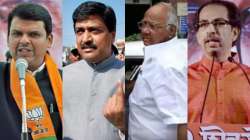A close electoral battle on cards in Maharashtra
After the Election Commission of India announced the polling dates, the campaigns are in full swing. The four key players in the battle are Bhartiya Janta Party, the Shiv Sena, the Congress, and the Nationalist Congress Party. Needless to say that the electoral battle is between the two alliances--the BJP-Shiv Sena vs Congress-NCP.

The Bhartiya Janta Party's performance in Maharashtra during the Lok Sabha 2019 elections had played a crucial role in rewarding the party a thumping majority.
Now, as the Maharashtra Assembly elections are around the corner, all the indications point towards the fact that the ruling BJP-Shiv Sena would have to fight it out.
After the Election Commission of India announced the polling dates, the campaigns are in full swing. The four key players in the battle are Bhartiya Janta Party, the Shiv Sena, the Congress, and the Nationalist Congress Party. Needless to say that the electoral battle is between the two alliances--the BJP-Shiv Sena vs Congress-NCP.
For the past two decades, the politics of Maharashtra has revolved around these two alliances, with both sides enjoying power at least once.
As the state elections in Maharashtra have generally been held in the same year as the Lok Sabha elections, the impact of the Lok Sabha election results on the state's elections can't be ignored.
Analysis of Lok Sabha and Assembly Election results since 1990 shows that the Lok Sabha elections by and large influenced the results of Maharashtra Assembly Elections. The data analysis shows that the voting pattern in one is closely related to the other.
During the 2019 Lok Sabha Elections, the BJP-Shiv Sena alliance was able to win 41 of Maharashtra's 48 parliamentary seats. In terms of vote share, the combine garnered 50.88 per cent votes in the state.
On the other hand, the Congress-NCP alliance won just 5 seats, but its vote share was 31.79 per cent, suggesting that while these two parties had their presence in the state but failed to concentrate their voters.
In 2014, the Shiv Sena and BJP failed to reach a mutual agreement for seat-sharing and decided to contest separately. This was the first time that either of the parties fielded candidates in almost all assembly seats in the state.
But when the results were out, the BJP emerged as the single-largest party with 122 seats (vote share 27.81 per cent) but still failed to reach the half-way mark of 144. The Shiv Sena, on the other hand, won 63 seats and had a vote share of 19.35 per cent. Soon, the two joined hands and formed the government. The BJP being the bigger partner got the chief minister's post.
In the 288-member Maharashtra assembly, the BJP and Shiv Sena's combined strength was 185 seats with a combined vote share of 47.16 per cent.
Meanwhile, the Congress-NCP won 83 seats (Congress 42, NCP 41) with a combined vote share of 35.19 per cent. This again was similar to their vote share in the 2014 Lok Sabha elections (34.41 per cent).
Interestingly, both BJP and Shiv Sena are especially popular in Maharashtra’s urban areas. For example, between the Lok Sabha elections of 2009 and 2019, the alliance’s vote share in urban areas more than doubled to 57%. As the state gets more urbanized, the BJP-Shiv Sena alliance’s stranglehold could get stronger.
The rise of the BJP-Shiv Sena alliance is also depended on the broad-based caste support which it has begun to enjoy, despite the caste-based agitations in recent years. The alliance is now tearing apart the traditional support base of the Congress and NCP. According to data from the Lokniti-CDS research program, the NCP, a Maratha-dominated party, could only get 28% of Maratha votes in the 2019 general elections compared to 39% for Shiv Sena.
But the difference among the leaders within the BJP-Shiv Sena alliance is perhaps a big weakness in the partnership. For instance, on various occasions, the Sena has publicly criticized the government's decisions. However, the Opposition has not been able to capitalize on that weakness.
However, the recent news regarding Sharad Pawar's name in an FIR and the PMC Bank crisis may just give fresh armour to the NCP-Congress in their fight against BJP-Shiv Sena.
Leaders in Maharashtra have already stated that it was time for Sharad Pawar to retire. Pawar retorted by saying, "Somebody said I am campaigning at this age. I am the president of your party. Don't say it again. Have I become old? Main bhi abhi jawan hoon (I too am still young). Don't worry, I will go home after sending these people (in power) home," he said.
The election results in Maharashtra will have important implications for the nation’s economy. Maharashtra is India’s most important state economically, contributing a steady 14% of national output over the past decade, because of Mumbai. However, this masks significant disparities. Vidarbha and Marathwada, which are largely agrarian, are far poorer than the more industrialized western Maharashtra region. Rural distress and a spate of farmer suicides in these areas might just pose a challenge for the Fadnavis-led government. However, Vidarbha has emerged as a stronghold for BJP, partly driven by the popularity of chief minister Devendra Fadnavis, who belongs to the region.
According to political analysts, most farmers still view BJP-led administration as saviour, because of the successful implementation of schemes such as Pradhan Mantri Kisan Yojana and payment of sugarcane dues, because of which sugarcane production, a critical component of Maharashtra’s rural political economy, is flourishing.
It would be interesting to see which way the voters decide but Maharashtra Election Results that will be declared on October 24 will have political implications not just for the state but for the country as well.